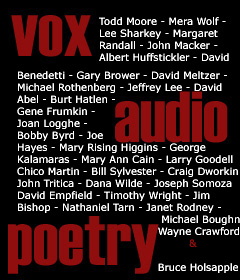
Herb Robertson
Music for The Long Attention Spans
Leo / CDLR315
Herb Robertson (trumpet, little instruments), Steve Swell (trombone), Bob Hovey (trombone, percussion, voice), Hans Tammen (guitar), Chris Lough (bass), Tom Sayek (drums)
a
a
a

Dominic Duval
Asylem
Leo / CDLR316
Dominic Duval (bass, electronics), Herb Robertson (trumpet, little instruments), Bob Hovey (trombone, turntable, voice), Jay Rosen (percussion)
Trumpeter Herb Robertson was a Berklee-trained fusioneer for much of the seventies. He discovered free jazz and the classical music of his century only later, but it is, as these things often are, now entered in his biog as his Damascus Road. For all the unpromising things this promises, however, Robertson is a son of Freddie Hubbard and Kenny Wheeler, a mercurial trumpeter with roots in hard bop reaching for the skies of the avant garde.

Herb Robertson | Photo: Peter Gannushkin
As such, “Music for Long Attention Spans” contains more composition than most of the free jazz discs mentioned in these pages, although it must still account for less than 1 per cent of the music as heard. The compositions are lumpy and instantly appealing, even catchy, and they’re presented in a way reminiscent of the Art Ensemble of Chicago, with a preference for atmosphere and exuberance over tight ensemble playing. This makes them a real pleasure to hear when they emerge, as they do from time to time, from the group interplay with a naturalness which is harder to achieve than it sounds.
Apart from the genuine versatility of his cohorts, Robertson offers considerable variety himself. As well as a virtuoso and uniquely personal trumpet style, he plays shambolic but fun melodica, keening whistles which add a touch of the ethno-forgery of much earlier free jazz projects and toys as well as ranting extraordinarily through a poem on the opening track, a funny and musically effective performance in itself. His style is not very showy, especially in this brass-heavy setting, but when he gets solo space his charms are undeniable. What’s more, when he’s working with the group he’s proactive, even interventionist, which is something quite rare in American jazz, where horning in on another player’s solo is so often grounds for hissy-fits in the dressing room.
The triple-brass frontline here is dynamic and at times challenging for all concerned, but all three keep their heads straight and interact with clarity. As for the rhythm section, Tammen’s extraordinary electric guitar is a loose cannon firing acid-coated missiles all over the deck, while Lough and Sayek pump out a relentless, but extremely varied, tidal pulse. This is a jazz band of splendid talents, and this record must be one of the most exciting in the Leo catalogue of those which fall firmly under that generic rubric. Full of unexpected moments, it is genuinely enthralling.
The album with Duval is a very different affair. Despite titles like “The Nightmare” and (oh dear) “Rectal Parasites”, it’s mostly a more relaxed joint, showcasing seven compositions by Bob Hovey (four co-written by Duval). Rosen is his characteristically twitchy but effective self, but Duval’s bass is in sexy, slinky mode for much of this set, and the overall feel is rather laid-bask in comparison with the above disc.

Dominic Duval /Photo: Peter Gannushkin
That’s not to say the music is trivial, or even any less serious. Hovey’s turntablism may not be particularly effective — speed it up! slow it down! spin it backwards! — but his compositions have a stateliness which has all kinds of pleasing resonances in the history of jazz. Robertson and Duval work beautifully together, and the aforementioned “Rectal Parasites” is a great example, with Duval sliding great, deep notes around the fingerboard in between his dramatic gestures while Robertson skywrites high above him. “Shadow 2”, meanwhile has a clever hocket arrangement of a bluesey theme which reminded this writer of Henry Threadgill, no faint praise in the composition stakes.
Rosen is a treasure, but his understanding of swing doesn’t always gel with Robertson’s more traditional version. This isn’t an ageist thing; Rosen comes from different traditions, and although he has some jazz in his playing he didn’t grow up listening and playing within that genre as intently as the trumpeter did. As a result, things can sometimes do slightly askew, rhythmically speaking, but at other moments the tension really fires both players to stretch in different directions.
This is a more easy-going set for the listener, but it may have been a more challenging one for the players. While the first disc is an unqualified hit, this is trickier to pin down. The emergence of Robertson on this side of the Atlantic is to be welcomed; the first disc listed here is the one to discover him with, but the second is interesting and shouldn’t be dismissed. Richard Cochrane



Leave a Reply